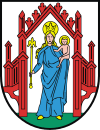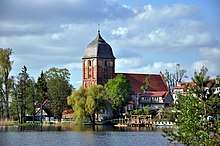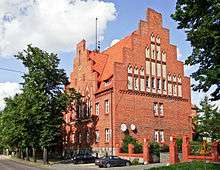Pasym
Pasym ([ˈpasɨm]; German: Passenheim)[1] is a small town in Szczytno County, Warmian-Masurian Voivodeship, Poland, with a total population (as of 30 June 2016) of 2,556. It is located in Masuria.
Pasym | |
|---|---|
 Town Hall | |
 Flag  Coat of arms | |
 Pasym | |
| Coordinates: 53°38′52″N 20°47′27″E | |
| Country | |
| Voivodeship | Warmian-Masurian |
| County | Szczytno |
| Gmina | Pasym |
| Area | |
| • Total | 15.18 km2 (5.86 sq mi) |
| Population (2016) | |
| • Total | 2,556 |
| • Density | 170/km2 (440/sq mi) |
| Postal code | 12-130 |
History

A small settlement named Heinrichswalde was first mentioned in 1381. In 1386 this settlement was renamed Passenheim after the Teutonic Knight Heinrich Walpot von Passenheim from modern Bassenheim near Koblenz.[2]
In 1441 the town joined the Prussian Confederation, at which request in 1454 King Casimir IV Jagiellon signed the act of incorporation of the region to the Kingdom of Poland, recognized the Polish king as rightful ruler and remained within Poland throughout the entire Thirteen Years’ War.[3] After the peace treaty signed in Toruń in 1466 it remained part of the State of the Teutonic Order and the Duchy of Prussia, a Polish fief until 1657.
The town was destroyed by the Tatar raids in 1656, which has been described by Christoph Hartknoch (1644–1687).[2] In the late 17th century Poles formed the majority of its population.[3]
In 1701 the town became part of the Kingdom of Prussia and subsequently, in 1871, it became part of Germany. In 1773 it was included in the newly established province of East Prussia. During the Napoleonic Wars, French troops stayed in Passsenheim in 1807 and 1812.[3] In 1883, Poles formed the majority of the local Lutheran parish (majority of the town's population was Lutheran), with 5,095 people in comparison to 1,015 Germans.[4]
In the East Prussian plebiscite of 1920 1,459 inhabitants voted to remain in Germany, 40 for Poland.[5] After World War II the region was placed under Polish administration by the Potsdam Agreement under territorial changes demanded by the Soviet Union. Most Germans fled or were expelled and replaced with Poles expelled from the Polish territories annexed by the Soviet Union or Ukrainians forced to settle in the area through Operation Vistula in 1947.

Notable residents
- Johann Wilhelm Ebel (1784–1861), Lutheran clergyman and teacher
- Marie-Luise Gothein (1863–1931), scholar, gardener and author
- Wawrzyniec Rast (1613-1673), Polish priest and scholar
- Christoph Hartknoch (1644-1687), teacher, historian, author
- Friedrich-Wilhelm Morzik (1891-1985), Luftwaffe general
International relations
References
- M. Kaemmerer (2004). Ortsnamenverzeichnis der Ortschaften jenseits von Oder u. Neiße (in German). p. 123. ISBN 3-7921-0368-0.
- Kossert, Andreas (2001). Masuren, Ostpreußens vergessener Süden. pp. 37ff. ISBN 3-570-55006-0.
- Słownik geograficzny Królestwa Polskiego i innych krajów słowiańskich, Tom VII, Warsaw, 1886, p. 890 (in Polish)
- Słownik geograficzny Królestwa Polskiego i innych krajów słowiańskich, Tom VII, Warsaw, 1886, p. 889 (in Polish)
- Passenheim
- Bassenheim.de Archived 2011-07-28 at the Wayback Machine
| Wikimedia Commons has media related to Pasym. |